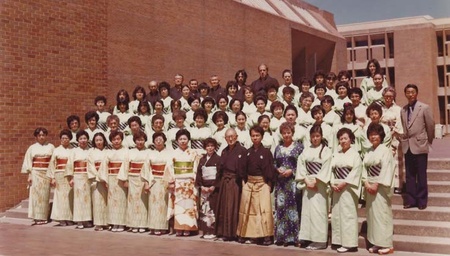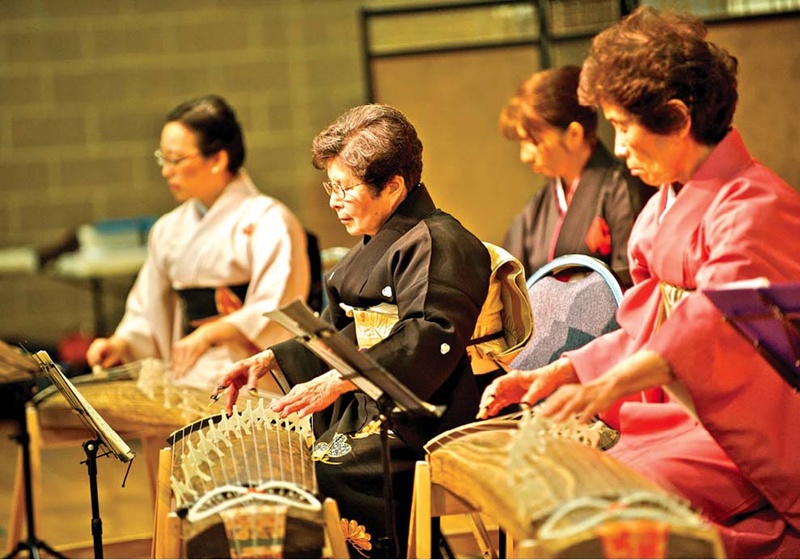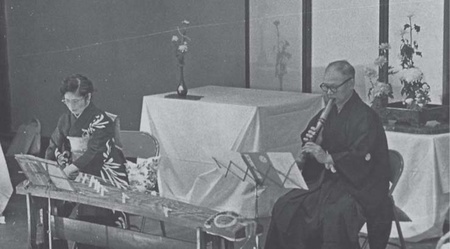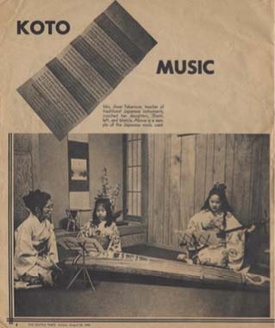Koto performer Miyagi Michio. Even if you don't know his name, every Japanese person has heard Miyagi's masterpiece, "Haru no Umi," a standard New Year's song. This time, we interviewed Takamura Kuniko, a direct disciple of Miyagi, who is an important figure that cannot be avoided when talking about Japanese music history. We will explore Kuniko's life with Japanese traditional music, who founded the Seattle Miyagi Association in 1959 and has been teaching koto and shamisen (jiuta samisen) for the past 60 years.
* * * * *
Professor Miyagi was a very quiet person. He told me, "Please spread the word about the koto in America." I'll never forget that.
—Kuniko Takamura
Meeting Mr. Miyagi, the "Father of Modern Japanese Music"
Takamura Kuniko has a soft way of speaking and a beautiful demeanor. I had heard that she was over 90 years old, but she didn't look it at all. When I asked her how old she was, she laughed and said, "I'm 96 this year." When I asked her the secret to her youth, she answered in a gentle tone, with a smile on her face, "Well, I guess it's because I'm carefree." Then, as if talking to herself, she added, "Young people come because young people come."
He naturally expresses gratitude to those around him. His modesty and politeness, as well as his exquisite refinement, are subtly apparent. While we were talking at his home and rehearsal space, he received many phone calls. It seems he is still very busy.
Kuniko was born in China in 1923. It was a time of constant conflict as imperialism was coming to an end. She returned to her parents' home country, Japan, at the age of 10. Her father stayed behind in China to work, and she grew up in Tokyo with her mother and siblings. She says she lived a relatively comfortable life. She started playing the koto when she was a schoolgirl. "Before that, I had studied piano and Nagauta, but it didn't really suit me, so I quit. My sister was really good at piano." At the recommendation of her koto teacher at school, she went on to study at the Tokyo Music School (now Tokyo University of the Arts).
At the time, Michio Miyagi was a professor in the Japanese music department. Despite being blind, he was known as a master of the koto and, above all, a great teacher who produced many famous pieces. He would later be called the "father of modern Japanese music," and his achievements were extraordinary, including incorporating elements of Western music into his works and performing with world-renowned violinists. Kuniko says she was always nervous when taking lessons with this great teacher.
However, the time was the height of World War II. The Great Tokyo Air Raids had begun. "I even went into the air raid shelter with Mr. Miyagi. Our house burned down in the air raids, so I evacuated to Yugawara in Kanagawa Prefecture. Mr. Miyagi also evacuated, and wasn't in Tokyo for a while." However, even after the war and graduating from university, he continued to study under Mr. Miyagi. He had his own students and continued to learn the koto from him for about 10 years.
When asked what her most memorable memory of Miyagi was, she took a moment to answer, probably with many thoughts running through her mind. "Miyagi sensei was a very quiet person. What I remember is when I told him that I had decided to go to America. He said, 'Please spread the word about the koto in America.' I'll never forget that. I thought to myself that I really don't have that kind of power." That was their last meeting. Miyagi died in a sudden accident one week later. Kuniko, who had just gotten married, heard the news during her honeymoon.
Traveling to America to share the sounds of the koto
Kuniko says that her late husband was the reason she ended up in Seattle. Her husband was a shakuhachi player, but was born in Japan, but had lived in the US as a member of his father's family, and had acquired US citizenship. "There are many Japanese who have lived in the US for decades and cannot return to Japan. I want you to let them hear the sound of the koto." She was invited by those words. In 1957, the year after she got married, she moved to Seattle, where her husband had a connection. Her husband, who had arrived in the US earlier, and his musical friends were waiting for the koto teacher who was coming from Japan. "The preparations were complete, and lessons began immediately." Many people learned the shamisen in Japanese American internment camps during the war, so a professional teacher who had graduated from a top university was very welcome.
In December 1959, they formed the Seattle Miyagi-kai, and began holding regular concerts twice a year, as well as many other concerts. At the 1962 Seattle World's Fair, their eldest daughter Marcia, who was still a child at the time, performed the koto and was met with great acclaim. They also went to Montana for a week-long koto performance at the request of the Seattle Consul General. They have endless stories to tell, including major concerts for milestones such as 10th and 20th anniversaries, performances at the request of hotels and golf courses, and collaborations with students who are also flute players. "We once went to Spokane to perform in a small plane. The plane almost crashed. When you've been doing it for 50 or 60 years, a lot of things happen." Kuniko has been recognized for her achievements in spreading the koto and traditional Japanese music in America, and has been awarded by the Minister of Foreign Affairs and the Miyagi-kai headquarters.
I end up crying instead of scolding them
When asked what Kuniko's character is like, one of her students, Kawahara Ritsuko, said, "She's just so kind." "Even if a student is struggling, the teacher won't say anything, so there have been times when I've had to step in and say something. She never says to a student who can't do it, 'Why don't you practice a bit at home?' I don't think she would say that. She never scolds."
Hearing this, Kuniko narrows her eyes and says, "Before I can scold them, I start crying." "When they don't understand no matter how many times I explain something, I feel pathetic. I end up crying because I feel like my teaching methods are so poor." Teaching is difficult. Kuniko's style is to resist the urge to just play the instrument herself, and watch over her students, hoping that they will think for themselves and realize something. "There are times when everyone understands something. Something that they couldn't do before suddenly becomes possible. At times like that, it makes us happy as teachers, and we rejoice together, saying, 'Oh, you did it!'" To date, she has taught around 200 students in Seattle.
During his heyday, he would also travel to Tacoma to teach. Many of the students were Japanese or Japanese-American, but there were also many Americans who were drawn to Japanese culture. "I have a white female student who has been coming from Bashon Island for about 30 years."
You teach traditional performing arts from different eras to people with different cultures and customs, who grew up in different environments. I imagine there were some students who made difficult requests and were difficult to deal with. "Yes, there were all kinds of people, but I've forgotten. I don't remember any difficult ones."
What remains the same
I would like to introduce an article that appeared in the Sunday edition of The Seattle Times in 1969. It reads, "In a residential area just up a hill from the International District. From the outside, the house appears to be ordinary, but inside it is a classical Japanese room with a tokonoma alcove, hanging scrolls and a display of traditional musical instruments." The article begins with this line and includes many photos of Kuniko and her apprentices, both in kimono, playing the koto, followed by a detailed explanation of the koto and shamisen. "KOTO is a 13-string instrument carved from a single piece of wood. When placed directly on the floor,
Students play the instrument by kneeling on the floor. It is an unfamiliar instrument to most people, but its beautiful sound can be heard in America through Japanese movies and records."
However, if you were born and raised in Seattle today, even if you have no connection to Japan, you have probably seen the traditional instrument "koto" at least once somewhere. This is thanks to the efforts of many people, including Kuniko, who have treasured Japanese culture while living in Seattle and performed it in public whenever they had the chance.
Unfortunately, the Japanese room described in the article no longer exists. The tokonoma alcove, handcrafted by her husband, burned down due to an electrical fault. Compared to its heyday, the number of members and regular performances has decreased. However, the group has some powerful helpers. Her eldest daughter, Marcia, is also in charge of teaching, and her second daughter, Sheri, learned how to restring koto instruments in Japan and takes on repairs in place of Kuniko, who is finding it difficult to do heavy work.
What hasn't changed is that the Seattle Miyagi Kai doesn't have a website, pamphlets, or signs. People who see a concert and talk to them, or hear about them through word of mouth, are the ones who become apprentices. The Seattle Miyagi Kai led by Kuniko will celebrate its 60th anniversary this fall. It seems that they are planning to hold a full-scale concert for the first time in a long time.

* * * * *
Kuniko Takamura
Born in China in 1923, he lived in Japan from the age of 10 and studied under his professor at university, Miyagi Michio. He became a master instructor at the Miyagi-kai, which was founded in 1951 by a group of Miyagi-kai disciples. He moved to Seattle in 1957 and founded the Seattle branch of the Miyagi-kai, the Seattle Miyagi-kai, in 1959.
Seattle Miyagi Association
Phone: 206-325-9285
Email: seattle.miyagikai@gmail.com
*This article is reprinted from Seattle lifestyle magazine Soy Source (March 8, 2019).
© 2019 Naoko Watanabe / Soy Source







